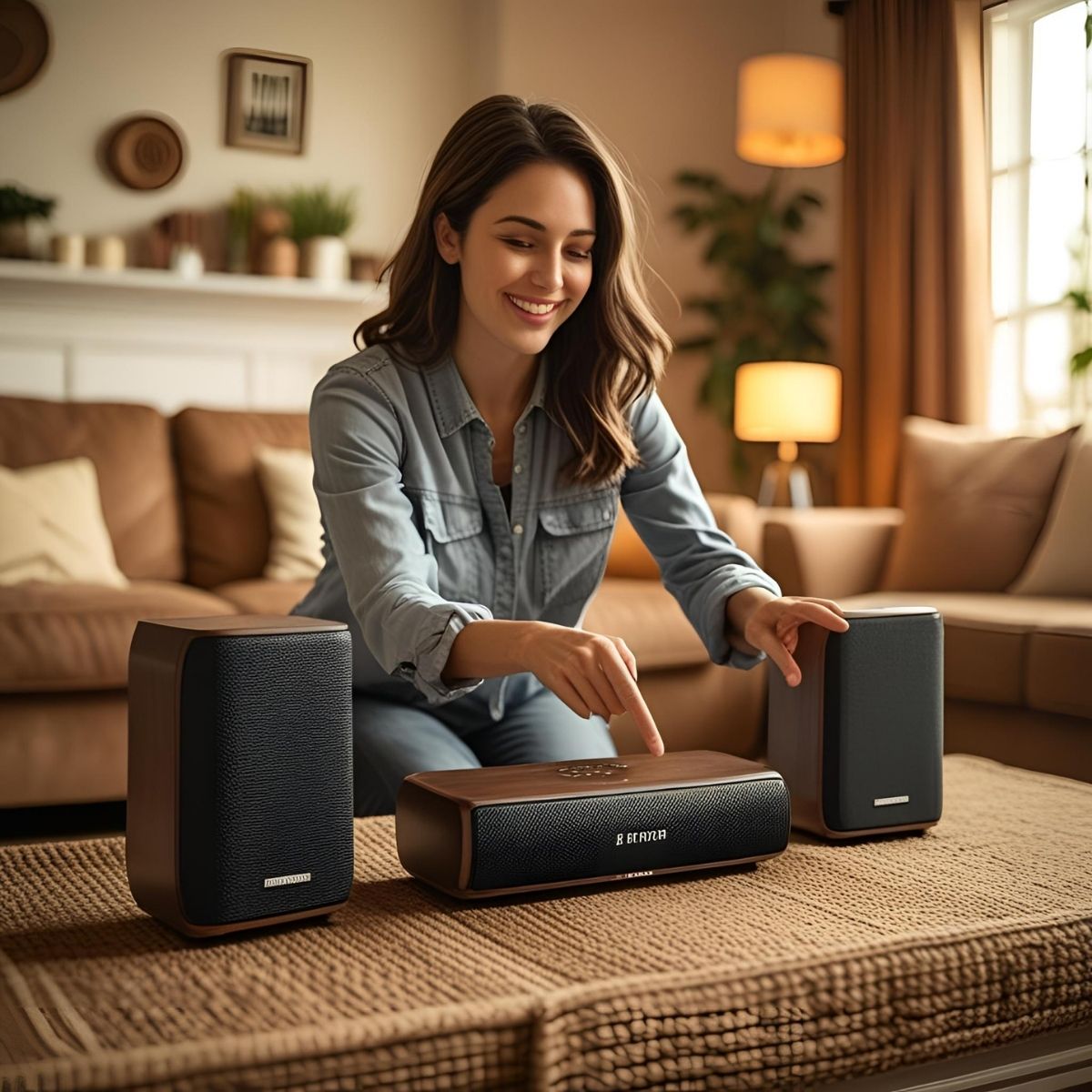
Table of Contents
Toggle1. Get the Best Sound from Your Bluetooth Speaker: Unlocking Your Bluetooth Speaker’s Full Potential
Bluetooth speakers are, without a doubt, one of the most popular and convenient audio devices today. They have freed us from wires, bringing our favorite soundtrack to any room in the house, to the park, or to the beach. However, many of us have experienced that slight disappointment: the sound is “good,” but not exactly “great.” Why doesn’t such a compact speaker deliver the punch you expected, or why does the audio seem a bit muffled?
The truth is that getting high-quality sound from a Bluetooth speaker goes far beyond just turning it on and connecting. Room acoustics, how you position it, and even digital settings play a crucial role.
This practical guide was created to unlock the secrets of portable audio. We’ll show you that you don’t need expensive equipment or deep technical knowledge to improve your experience. You’ll learn essential tips on ideal speaker placement, how to adjust equalization (EQ) settings to your taste and environment, and tricks to ensure the best possible Bluetooth connection.
Our goal is simple: to help you get the absolute best sound from your Bluetooth speaker, transforming your listening experience from good to truly exceptional.
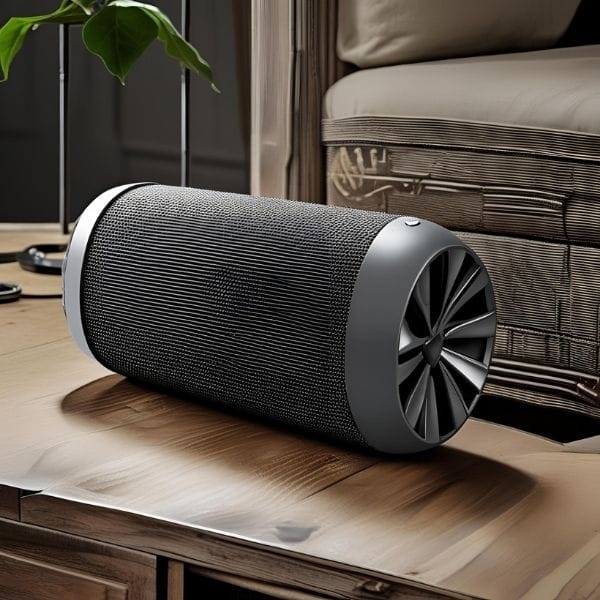
2. The Foundation: Bluetooth Connection & Pairing Tips
Before we dive into positioning and EQ adjustments, we need to ensure the foundation is solid: your Bluetooth connection. The quality of the audio your speaker reproduces directly depends on the stability and fidelity of the Bluetooth signal it receives. A weak or unstable connection can result in audio dropouts, interruptions, or even inferior sound quality.
Recommended Pairing Practices
To ensure your speaker and device (smartphone, tablet, laptop) are communicating optimally, follow these tips:
- Simple Re-Pairing (Disconnect and Reconnect): If you’re experiencing interruptions, dropouts, or low audio quality, the most basic and often effective solution is to simply disconnect the speaker from your device and pair it again. This “resets” the connection and can resolve minor bugs.
- “Forget Device”: If you’ve paired your speaker with multiple devices over time (your old phone, a friend’s tablet, your laptop), there might be conflicts. Go to the Bluetooth settings on all devices that have been connected and select the “Forget” or “Unpair” option for the speaker. Then, pair it again only with the device you intend to use. This eliminates potential interference from previous connections.
- Clear Line of Sight: Bluetooth works best when there’s a direct line of sight between your source device and the speaker. Physical obstacles like walls, large furniture, and even your own body can degrade signal quality and connection stability. Try to keep the speaker and device in the same room with no major barriers between them.
- Distance Matters: Although modern Bluetooth has a decent range, connection quality is inversely proportional to distance. For a more consistent and high-fidelity connection, try to keep your device within about 10 meters (33 feet) of the speaker. The closer, the more stable and robust the signal will be.
- Minimize Interference: Other wireless devices (like Wi-Fi routers, cordless phones, and even other nearby Bluetooth devices) can cause interference. For critical listening sessions or when quality is paramount, try to keep the speaker and source device away from other wireless signal sources.
Bluetooth Codecs: A Brief Understanding
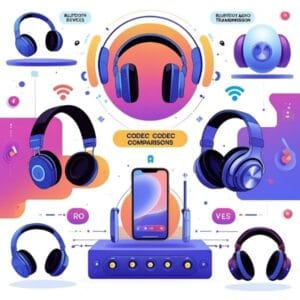
Not all Bluetooth connections are created equal. Bluetooth codecs are the algorithms that encode and decode audio for wireless transmission. Simply put: better codecs can transmit more audio data, resulting in higher sound quality.
- SBC: The basic and universally supported codec. It works, but it’s not the best for fidelity.
- AAC: Commonly used by Apple devices and offers better quality than SBC.
- aptX (HD, Low Latency, Adaptive): Developed by Qualcomm, it offers better quality and lower latency, especially in its more advanced versions.
- LDAC: A high-resolution codec from Sony that allows transmitting audio at a much higher bit rate, almost CD-quality (or better).
The important thing is: both your source device and your Bluetooth speaker need to support the same high-quality codec for you to enjoy its benefits. Check your hardware specifications!
Source Quality Also Counts
Finally, remember the audio maxim: “garbage in, garbage out.” Even the best speaker in the world won’t make a low-quality audio file (like a heavily compressed MP3 or a low-bitrate stream) sound good. To get the best sound from your Bluetooth speaker, use good quality audio files or streaming services that offer high-fidelity options.
With a solid connection and a quality source signal, you’ll be ready to explore the next level of sound optimization.
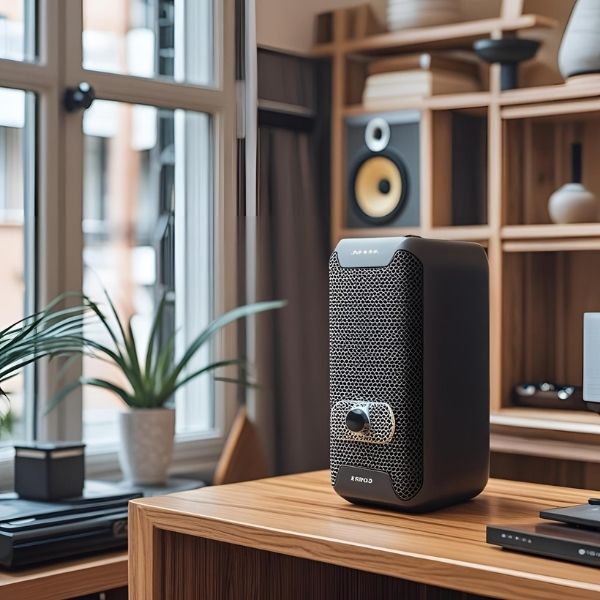
3. The Art of Placement: Where You Put It Matters
You can have the most expensive Bluetooth speaker in the world, but if its positioning isn’t good, the sound will never reach its maximum potential. Room acoustics are a crucial factor, and knowing how sound interacts with the surrounding space is fundamental to getting the best sound from your Bluetooth speaker.
Interaction with the Environment
Every surface and object in a room affects how sound propagates.
- Walls and Corners:
- Bass Boost: Placing your Bluetooth speaker near a wall, or even more so, in a corner, can significantly increase bass. This happens due to a phenomenon called acoustic coupling, where surfaces reflect bass sound waves, amplifying them. For some music or in open spaces, this might be desirable. But beware: in small environments, it can result in a “muddy” or excessively “boomy” sound, overpowering the rest of the audio. Try moving the speaker a few inches away from the wall to see how the sound changes.
- Muffled Sound: On the other hand, avoid placing the speaker too close to soft, absorbent surfaces like heavy curtains, large sofas, or pillows. These materials can “suck up” high frequencies (treble), leaving the sound feeling muffled and lacking clarity.
- Open vs. Enclosed Spaces: A Bluetooth speaker will sound different in an open space (like a park) than in an enclosed environment (like a room). In open spaces, sound disperses more freely, and you might need more volume and a slight bass boost. In an enclosed environment, sound reflects off the walls, potentially creating echo or reverberation if not well-positioned.
Height and Orientation
Where the speaker is vertically and which way it’s pointed also makes a big difference.
- Ear Level: Ideally, the speaker should be positioned approximately at the height of your ears when you are in your main listening position (sitting on the couch, for example). This ensures that mid frequencies (voices, instruments) and high frequencies (treble) reach you directly, providing ideal clarity and detail.
- Obstructions: Make sure nothing is directly blocking the speaker drivers (the parts that emit sound). Objects, books, or even the edge of a shelf can hinder sound dispersion.
- Directionality: Not all Bluetooth speakers are alike. Some are designed for 360-degree sound, filling the room uniformly. Others are front-facing, meaning the best sound is in front of them. Position your speaker according to its design to direct the sound where you want it to go.
Stereo Pairing (If Applicable)
If you have two Bluetooth speakers of the same model that can be paired in stereo mode, you can create a much more immersive sound experience.
- Speaker Spacing: For a proper stereo soundstage, position the speakers a reasonable distance from each other. A good rule of thumb is for the distance between them to be approximately the same distance from you to each speaker.
- Triangular Configuration (“Sweet Spot”): The most ideal arrangement is to form an equilateral triangle where you and the two speakers form the three vertices. This creates a “sweet spot” – an ideal point where balance and stereo imaging are perfect. Experiment with moving the speakers and your listening position until you find this magic spot.
With strategic positioning, you’ll already be halfway to transforming your Bluetooth speaker experience.
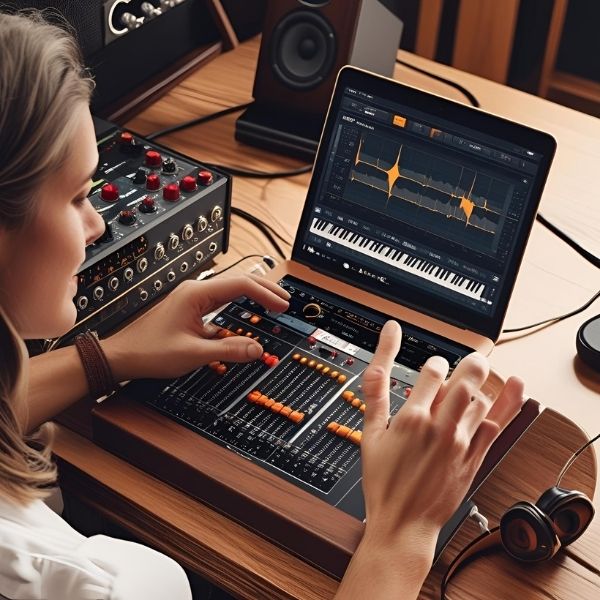
4. Fine-Tuning with EQ: Shape Your Sound
After perfecting your Bluetooth connection and speaker placement, the next step to truly customize your audio is through Equalization (EQ). Think of EQ as your personal sound sculptor. It’s a powerful tool that lets you adjust the balance of different frequency ranges—like the bass (lows), mids, and treble (highs)—to suit your personal preference, compensate for your listening environment’s acoustics, or even enhance specific music genres.
Where to Find EQ Settings
Modern Bluetooth speakers and smart devices offer several ways to tweak your sound:
- Speaker Companion Apps: Many popular Bluetooth speaker brands, like JBL, Sonos, Bose, and Sony, provide dedicated smartphone apps. These apps often include built-in EQ controls that allow you to fine-tune the sound profile directly from your phone. This is usually the most effective method, as the app is designed specifically for your speaker’s hardware.
- Source Device EQ: Your smartphone, tablet, or even streaming apps often have their own native EQ settings. For example, Spotify and Apple Music typically have EQ presets, and iOS devices have a system-wide EQ accessible through settings. While these can offer a quick adjustment, remember they apply the EQ before the sound reaches the speaker, and might not be as precise as a speaker’s dedicated app.
Basic EQ Adjustments
When you see an EQ interface, you’ll usually find sliders or knobs for different frequency bands. Here’s a simple guide to what they do:
- Boosting Bass (Lows):
- When to do it: Great for adding “punch” to electronic music or if you’re listening in a large, open outdoor space where bass tends to dissipate.
- When not to: Avoid over-boosting bass in small, enclosed rooms, as it can make the sound muddy, boomy, or overwhelming. Less is often more.
- Clarifying Mids (Mid-range):
- The mid-range is where vocals and many instruments (guitars, pianos) reside. If vocals sound distant or unclear, a slight boost in the mids can bring them forward and add clarity to the mix.
- Brightening Treble (Highs):
- Boosting treble adds “sparkle” and detail to cymbals, strings, and high-pitched vocals. If your audio sounds dull, a subtle increase here can make it feel livelier.
- Avoiding Over-EQing: The biggest mistake beginners make is pushing EQ sliders to their extremes. This can lead to distortion, harshness, or a completely unnatural sound. Always start with subtle adjustments and listen carefully to the effect. Small changes often make a big difference.
Experimentation is Key
There’s no single “perfect” EQ setting. The ideal balance depends on your personal preference, the type of music you’re listening to, and the acoustics of your current environment. Don’t be afraid to experiment! Play a familiar song, make a small adjustment, listen, and repeat. You’ll quickly develop an ear for what sounds best to you and how to tailor your speaker’s output for any situation.
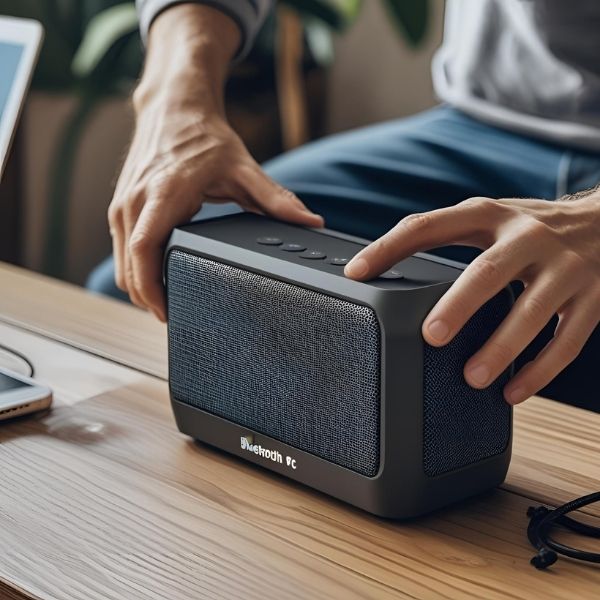
5. Beyond the Basics: Other Optimization Tips
Once you’ve mastered connection, placement, and EQ, there are a few other often-overlooked factors that can significantly impact your Bluetooth speaker’s performance and longevity. These simple tips ensure you’re consistently getting the best sound from your Bluetooth speaker.
Battery Life Impact
It might seem obvious, but a speaker running on a low battery can sound noticeably worse. As the battery drains, some speakers might automatically reduce their maximum volume, or even limit bass output, to conserve power. This happens because producing deep bass requires more energy. To ensure consistent performance and avoid a diminished sound experience, always keep your Bluetooth speaker adequately charged. Ideally, don’t let it dip below 20-30% during extended listening sessions.
Firmware Updates Are Crucial
Think of firmware as the operating system for your speaker. Manufacturers frequently release firmware updates to improve performance, fix bugs, enhance connectivity, add new features, and even refine sound quality. Ignoring these updates can leave your speaker underperforming or vulnerable to issues.
- How to Update: Most modern Bluetooth speakers are updated via their companion app. Simply connect your speaker to the app, and it will usually notify you if an update is available. Make sure your speaker is charged and connected during the update process to avoid interruptions.
Source Audio Quality
Even the most premium Bluetooth speaker can only reproduce the sound it receives. This means that the quality of your audio source is paramount.
- Garbage In, Garbage Out: If you’re streaming highly compressed MP3s or using a streaming service on its lowest quality setting, your speaker won’t magically make it sound high-fidelity.
- Prioritize High-Quality Audio: For the best experience, use high-quality audio files (like FLAC or WAV) or subscribe to streaming services that offer higher-resolution audio (e.g., Spotify Premium, Apple Music Lossless, Tidal, Qobuz). The better the data flowing into your speaker, the better the sound flowing out.
Cleaning & Basic Maintenance
Finally, a little care goes a long way. Dust, dirt, and debris can accumulate on speaker grilles and drivers, potentially affecting sound clarity over time.
- Gentle Cleaning: Use a soft, dry cloth or a soft brush (like a clean paintbrush) to gently remove dust from the grille. For stickier grime, a slightly damp cloth can work, but avoid getting moisture directly into the drivers or ports.
- Keep Ports Clear: Ensure the charging port and any auxiliary input ports are free from lint or debris.
By paying attention to these “beyond the basics” tips, you’ll not only maximize your speaker’s immediate sound quality but also ensure its optimal performance and longevity for years of listening pleasure.
6. Conclusion: Listen Smarter, Not Just Louder
Your Bluetooth speaker is an incredibly versatile audio tool, but to truly unlock its maximum potential and enjoy the sound quality it’s capable of delivering, you need to go beyond “plug and play.”
By mastering the strategic placement of your Bluetooth speaker, adjusting equalization (EQ) to suit your taste and environment, and ensuring a solid Bluetooth pairing, you transform an ordinary listening experience into something truly exceptional. Remember also to keep your speaker charged, updated, and fed with high-quality audio sources.
Getting the best sound from your Bluetooth speaker isn’t a mystery, but rather the result of some smart practices. We encourage you to experiment with each of these tips. Feel the difference that the distance from a wall, a small bass adjustment, or a stable connection can make.
Your Bluetooth speaker holds much more potential than you imagine. Unleash it!
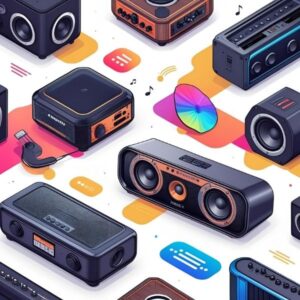
Further Resources: Unleash Your Bluetooth Speaker’s Potential
Ready to truly master your portable audio experience? Dive deeper into optimizing your Bluetooth speaker with these valuable resources:
📚 Internal Links: More from Gear For Audio
- Best Portable Bluetooth Speakers for Outdoors
- High-Resolution Audio Streaming: Is it Worth the Upgrade?
- The Unsung Hero of Audio Quality & Longevity: Your Guide to Clean Audio Gear
- Headphone Drivers Explained: What You Need to Know for Optimal Sound
- Top Earbud Brands of 2025
🔗 External Links: Deep Dive into Bluetooth & Audio Science
- Bluetooth SIG (Special Interest Group): The official body overseeing Bluetooth standards. Learn about the technology directly from the source: Visit Bluetooth.com
- Qualcomm aptX: Explore the technology behind aptX codecs for enhanced Bluetooth audio quality: Visit aptX.com
- Sony LDAC Information: Understand Sony’s high-resolution audio codec for Bluetooth: Learn about LDAC
- Crutchfield – Room Acoustics Guide: A fantastic resource for understanding how your environment impacts sound and practical speaker placement tips: Read Crutchfield’s Guide


Pingback: The Secret Of Perfect Sound In Your Pocket: What No One Tells You About Your Earbuds.